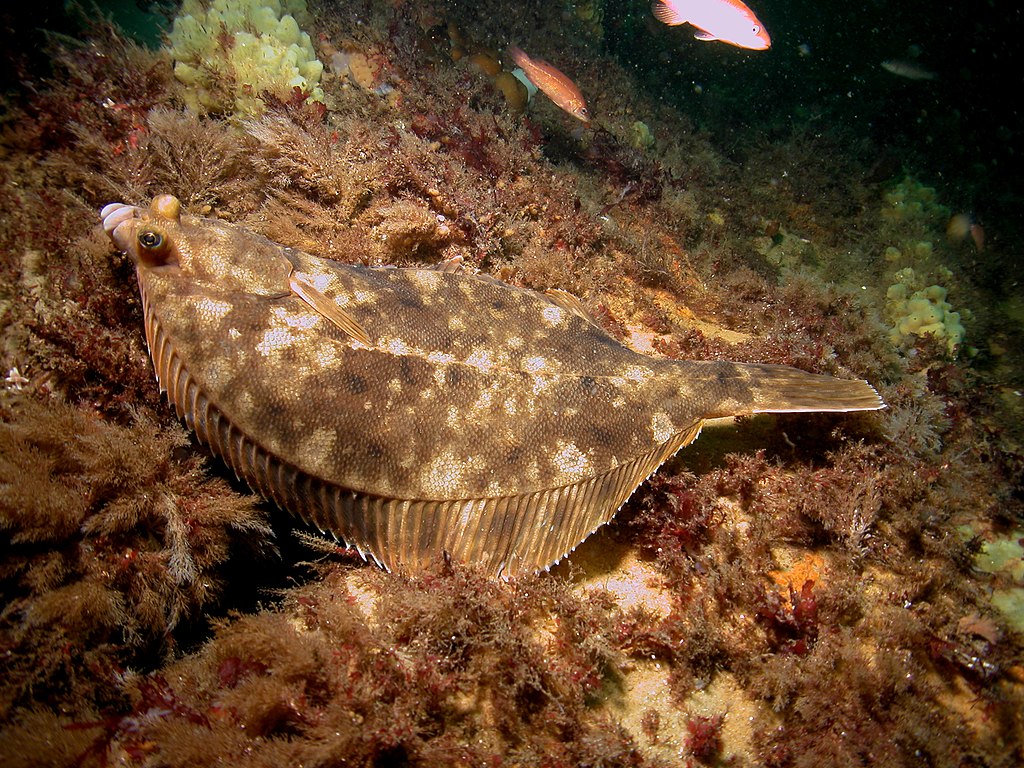
Flounder
Scientific Name: Paralichthys spp.
Also known as: Southern Flounder, Gulf Flounder, Winter Flounder
General Description
Flounder are a unique and highly sought-after species of flatfish that are well-known for their distinctive body shape, which is flat and elongated, allowing them to blend seamlessly with the ocean floor. They have both eyes on one side of their body, typically the right, and their undersides are white, which helps them camouflage against the seafloor. These fish are prized for their delicate, mild-flavored flesh and are a popular target for both recreational and commercial fishermen.
Flounders are carnivorous and feed primarily on small fish, crabs, and shrimp. They are opportunistic predators, using their flat bodies to ambush prey from the bottom. Flounder species vary in size depending on the type, with some like the Southern Flounder growing up to 24 inches long, while the Winter Flounder generally stays smaller. Despite their size, they put up a strong fight when hooked, especially when using light tackle.
These flatfish have a distinctive feeding behavior and are often found buried in the sand or mud in shallow waters. Their excellent camouflage allows them to remain unnoticed until they strike at prey, which is why they are such an exciting challenge for anglers.
Where to Find Them
Flounders are predominantly found along the coastal waters of the Atlantic and Gulf of Mexico, where they thrive in shallow, sandy, or muddy environments. They are typically found in estuaries, bays, and on the continental shelf, where the water is warmer. Flounder species are known to migrate between shallow and deeper waters depending on the season. For example, the Southern Flounder is abundant in the Gulf of Mexico, from Texas to Florida, and they are commonly caught in both shallow estuarine waters and deeper offshore regions.
During the warmer months, Flounder tend to move into shallow bays, estuaries, and tidal creeks, especially where there is a mixture of sand and mud bottom. These fish are attracted to areas with some structure, such as submerged rocks, sandbars, and jetties. In winter, Flounder retreat to deeper waters and migrate offshore, where they stay in slightly cooler, deeper habitats. Flounder can also be found along the Atlantic coastline, particularly from Maine down to Florida, as well as the Gulf Coast from Louisiana to Florida.
Anglers can often find Flounder near piers, docks, and tidal flats where they are likely to feed on baitfish and crustaceans. In areas like the Carolinas and Texas, fishing for Flounder in the fall and winter months can be particularly productive.
Best Baits
Live Bait Options
- Live shrimp
- Finger mullet
- Mud minnows
- Live sandworms
- Small baitfish (like menhaden)
Artificial Bait Options
- Soft plastics (swimbaits, curly tail grubs)
- Spoons (gold or silver)
- Jerkbaits
- Bucktail jigs
- Soft plastic flounder imitations
- Crankbaits (especially for deeper fishing)
Fishing Methods
Flounder fishing is popular both from the shore and on boats, with different methods working well depending on the location and time of year. Bottom fishing is the most effective method for targeting these flatfish. The key is to fish near the seafloor, where Flounders spend most of their time. Using light tackle, anglers can cast live or cut bait, such as shrimp, finger mullet, or mud minnows, and let the bait sink to the bottom. Slowly dragging the bait along the seafloor can often provoke a bite from the hidden Flounder.
Another effective method is drift fishing in shallow waters or near structure, using soft plastics or jigs. A slowly retrieved bucktail jig or soft plastic swimbait is often irresistible to Flounder, especially when fished close to the bottom. Fishing with a jighead and soft plastic bait is also a highly effective technique in both shallow and deep waters. The action of the jighead mimics a wounded or dying fish, which Flounder find attractive.
For pier fishing, anglers can use weighted rigs to get their bait close to the bottom. Live shrimp and mullet work well here, as the Flounder are often attracted to the abundant forage around piers. During the night, Flounder often come closer to the shore to feed, so night fishing is another productive option.
Fly fishing for Flounder is also possible in the shallow, flat environments they prefer. Fly anglers use clouser minnows or other small baitfish imitations for success. In deeper water, anglers may use sinking lines to reach Flounder at the right depth.
Summary
Fishing for Flounder offers anglers a rewarding experience due to the species’ unique appearance and strong fight when hooked. These flatfish are well-adapted to life on the seafloor, where they spend most of their time ambushing small fish and crustaceans. Flounders can be found along the Atlantic and Gulf coasts, with the Southern Flounder being particularly abundant in estuarine and shallow coastal areas. Their preference for sandy and muddy bottoms makes them an ideal target for bottom fishing and drift fishing.
The most common baits for Flounder include live shrimp, mud minnows, and finger mullet, though soft plastics, jigs, and spoons can also be effective. Anglers often use light tackle to fish near the bottom of estuaries, bays, and along piers. Drift fishing with jigs or soft plastics is one of the most popular and successful methods, as is bottom fishing with live or cut bait. Fly fishing is another viable option, especially in shallow areas where Flounder hunt.
Flounder are most active during the warmer months when they move into shallower waters, but fishing for them can be productive year-round, with winter months being an excellent time to fish for them in deeper waters. Whether you are fishing along the Gulf Coast or in the waters off the Atlantic, Flounder fishing provides an exciting and challenging opportunity for anglers of all skill levels.


